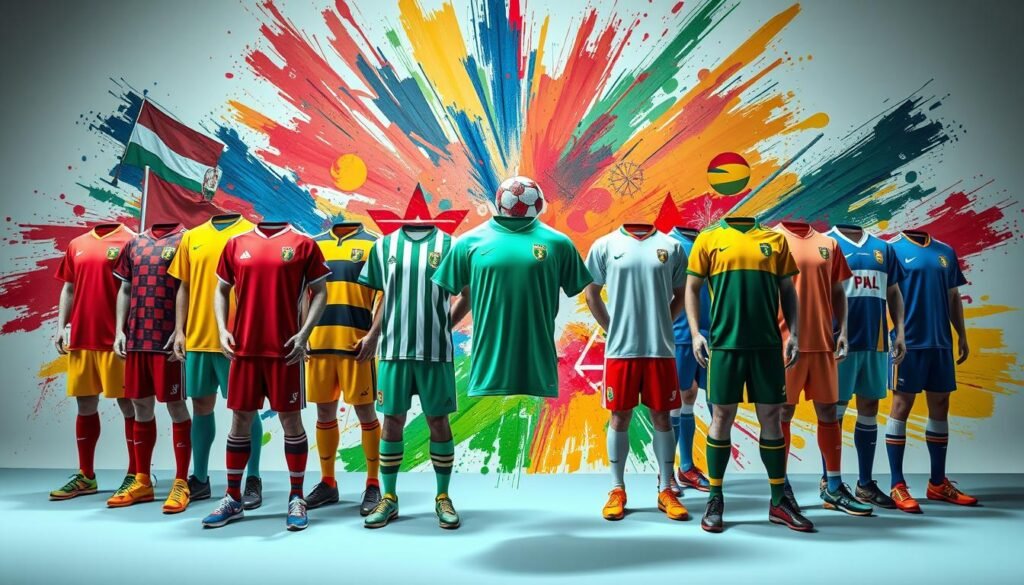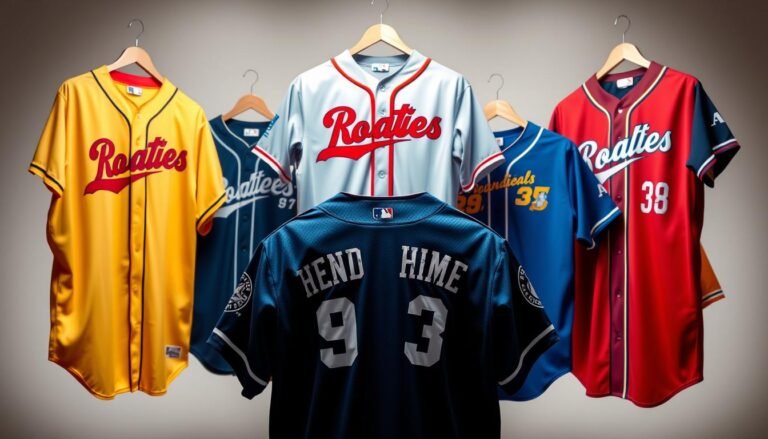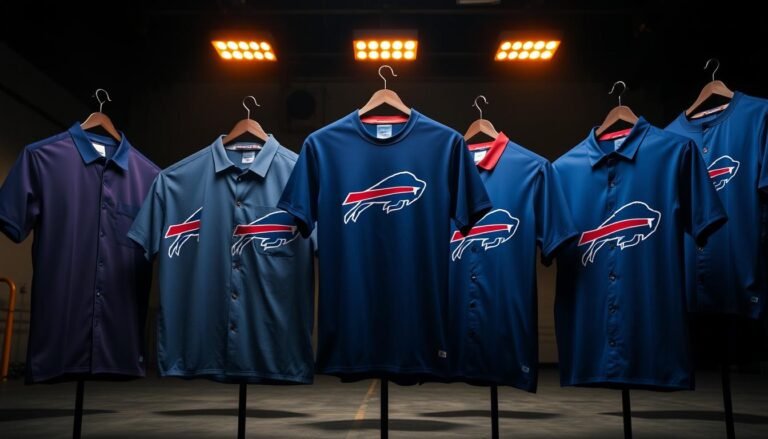Jersey colors play a crucial role in sports, influencing team identity, player psychology, and fan engagement. The choice of colors can evoke emotions, convey messages, and create a lasting impression on spectators.
The symbolic meanings behind jersey colors can affect the outcome of games and the overall fan experience. Teams carefully select their colors to represent their values, history, and brand, making jerseys an integral part of their identity.
Understanding the impact of jersey colors can provide insights into team dynamics, fan behavior, and the psychological aspects of sports.
Key Takeaways
- Jersey colors influence team identity and player psychology.
- The choice of colors can evoke emotions and convey messages.
- Jerseys are a crucial part of a team’s brand and history.
- The symbolic meanings of colors can impact game outcomes.
- Understanding jersey colors can provide insights into team dynamics.
The Evolution of Sports Jerseys and Team Colors
The development of sports jerseys and team colors is a story of gradual innovation and identity formation. As sports evolved, the need for distinctive uniforms became apparent, leading to the diverse range of jerseys we see today.
Early History of Sports Uniforms
In the early days of organized sports, teams often wore simple, unstandardized uniforms that lacked distinctive colors or designs. The first sports jerseys were primarily functional, made from materials like cotton or wool. As sports gained popularity, the need for differentiation became more pressing, leading teams to adopt unique colors and designs that would eventually become a hallmark of their identity.
How Team Colors Became Central to Identity
As sports continued to grow, team colors became an integral part of a team’s branding. Teams began to select colors that reflected their values, location, or cultural heritage. This process not only helped to distinguish teams from one another but also fostered a sense of unity and belonging among players and fans. The choice of team colors was often influenced by local traditions, historical events, or symbolic meanings associated with certain colors.
Modern Developments in Jersey Design
Modern sports jerseys are a far cry from their early counterparts, with advancements in technology and design leading to more sophisticated and varied jersey designs. Today, teams have the flexibility to experiment with different colors, patterns, and materials, allowing for a greater expression of their identity. The incorporation of advanced materials has also improved player comfort and performance, further enhancing the role of jerseys in sports.
The Psychology Behind Color Choices in Sports
The psychology of color in sports is a fascinating area that explores how different hues can impact player performance and team morale. Colors can influence the psychological state of athletes, potentially affecting the outcome of a game.
How Colors Affect Player Performance
Research has shown that certain colors can enhance player performance. For instance, the color red is often associated with increased heart rate and aggression, potentially giving teams wearing red jerseys a competitive edge.
Research on Red’s Performance Enhancement
Studies have indicated that athletes wearing red tend to perform better in competitive situations. This is attributed to the psychological effects of red, which can increase feelings of dominance and competitiveness.
Blue and Its Calming Effects
On the other hand, blue is known for its calming effects. Teams wearing blue jerseys may experience reduced anxiety and improved focus, potentially leading to better performance under pressure.
Intimidation Factor: Dark vs. Bright Jerseys
The intimidation factor of jersey colors is another crucial aspect. Dark colors are often perceived as more intimidating, while bright colors can be seen as more approachable. This perception can influence how teams are viewed by their opponents and potentially affect game dynamics.
| Jersey Color | Perceived Effect | Potential Impact |
|---|---|---|
| Red | Increased aggression | Competitive edge |
| Blue | Calming effect | Improved focus |
| Dark Colors | Intimidating | Psychological advantage |
Visibility and Practical Considerations
While the psychological impact of colors is significant, practical considerations such as visibility are also crucial. Teams must balance the psychological effects of their jersey colors with the need for visibility on the field.

The Significance of Jersey Colors in Sports Branding
In the world of sports, jersey colors are not just about aesthetics; they are a strategic element that can significantly impact a team’s brand strength and commercial success. The colors chosen for a team’s jersey are a fundamental aspect of its identity, influencing how the team is perceived by fans, sponsors, and opponents alike.
Creating Recognizable Team Identities
Jersey colors play a vital role in creating a recognizable team identity. A well-designed jersey with a distinctive color scheme can become an iconic symbol of a team, instantly recognizable to fans worldwide. For instance, the bright orange of the Cleveland Browns or the deep purple of the Minnesota Vikings are identities that are deeply ingrained in the NFL. Such distinctiveness is crucial for building a strong brand that resonates with fans and fosters loyalty.
Merchandising and Commercial Impact
The commercial impact of jersey colors is significant, driving merchandise sales and reinforcing the team’s brand. Fans are more likely to purchase jerseys, hats, and other merchandise that feature their team’s colors, making color an essential element of merchandising strategies. Teams with strong, recognizable colors tend to have a competitive edge in the market, as their branding is more likely to stand out and be remembered.
Color Consistency Across Team Properties
Maintaining color consistency across all team properties, including jerseys, merchandise, and marketing materials, is crucial for reinforcing the team’s brand identity. Consistency in color usage helps to create a cohesive brand image that is instantly recognizable. This consistency is not just limited to the team’s visual identity but also extends to the overall brand experience, enhancing its appeal to fans and sponsors alike.
By understanding the significance of jersey colors in sports branding, teams can leverage their visual identity to build a stronger brand, enhance fan engagement, and drive commercial success.
Cultural and Regional Influences on Team Colors
The choice of team colors in sports is often a nuanced blend of cultural identity, regional pride, and historical significance. This complex interplay results in a diverse array of colors that not only represent teams but also reflect broader cultural and regional influences.
National Colors in International Competitions
In international competitions like the World Cup, national colors take center stage, symbolizing national pride and identity. Teams often wear colors that are deeply ingrained in their national heritage, such as Brazil’s yellow and green or Italy’s blue.
Local Heritage and Community Connections
Local heritage and community connections also significantly influence team colors. For instance, teams may adopt colors that are associated with their city’s history or cultural symbols, fostering a strong sense of community and local identity.
Color Traditions in Different Sports
Different sports have their own color traditions. For example, in baseball, teams often have classic color schemes that evoke a sense of tradition and nostalgia, while in soccer, teams may have more vibrant and dynamic color schemes that reflect their cultural and national identity.

| Sport | Common Color Schemes | Cultural Influence |
|---|---|---|
| Baseball | Classic, traditional colors (e.g., red, white, blue) | Reflects American heritage and nostalgia |
| Soccer | Vibrant, dynamic colors (e.g., green, yellow, blue) | Influenced by national and cultural identities |
| Basketball | Bold, contrasting colors (e.g., red and black, blue and white) | Reflects urban culture and team identity |
Understanding these cultural and regional influences on team colors enhances our appreciation of the rich tapestry of sports identities and the significance of jersey colors in the world of sports.
Strategic Advantages of Certain Jersey Colors
The strategic selection of jersey colors is a crucial aspect of team sports, offering a competitive edge through enhanced visibility and psychological impact. Teams have long understood that their jersey colors can influence the game’s dynamics, from player performance to spectator perception.
Contrast and On-Field Visibility
One of the primary considerations in choosing jersey colors is contrast and on-field visibility. High contrast between jersey colors and the environment can significantly enhance player performance and reduce errors. For instance, a team wearing bright colors against a darker background can gain an advantage in visibility, making it easier for players to see each other and react quickly.
Weather Considerations and Color Selection
Weather conditions also play a crucial role in jersey color selection. Light colors can reflect sunlight, keeping players cooler in warm conditions, while dark colors can absorb heat, potentially leading to discomfort. Conversely, in colder or overcast conditions, darker colors might be preferable as they can absorb what little sunlight is available.
Home vs. Away Color Dynamics
The dynamics between home and away jersey colors can also provide a strategic advantage. Teams often have a preferred home color that is associated with their identity and fan base. Away jerseys, on the other hand, are designed to contrast with the home team’s colors, reducing visual confusion for players and officials. This contrast can affect the psychological aspect of the game, with some teams feeling more confident in their home colors.
Iconic Jersey Colors in American Sports
The iconic jerseys of American sports teams are more than just uniforms; they represent tradition, success, and fan loyalty. These colors have become an integral part of the sports culture, evoking emotions and creating a sense of identity among fans.
NFL Team Colors and Their Stories
The NFL is home to some of the most recognizable jersey colors in sports. Teams like the Green Bay Packers and Pittsburgh Steelers have jerseys that are steeped in history and tradition.
Green Bay Packers’ Green and Gold Legacy
The Green Bay Packers’ iconic green and gold colors are a symbol of the team’s rich heritage. The colors have been a part of the team’s identity since its inception and are deeply ingrained in the community.
Pittsburgh Steelers’ Steel City Identity
The Pittsburgh Steelers’ black and gold jerseys reflect the city’s steel industry heritage. The team’s colors are a nod to the city’s history and industrial past.
NBA’s Most Recognizable Jerseys
The NBA has its fair share of iconic jerseys, with teams like the Los Angeles Lakers and Chicago Bulls leading the way. Their jersey colors have become synonymous with success and excellence.
Lakers Purple and Gold Dynasty
The Los Angeles Lakers’ purple and gold jerseys are iconic in the world of basketball. The colors have been associated with the team’s numerous championships and Hall of Fame players.
Chicago Bulls’ Red Revolution
The Chicago Bulls’ red and black jerseys were a defining feature of the team’s success in the 1990s. The colors became synonymous with the team’s dominant performance and Michael Jordan’s legacy.
MLB and NHL Color Traditions
Both MLB and NHL have their own unique color traditions. From the classic red and white of the St. Louis Cardinals to the bold blue and orange of the Florida Panthers, each team’s jersey colors tell a story of their history and identity.
In conclusion, the iconic jersey colors in American sports are a reflection of the teams’ histories, values, and communities. They evoke emotions and create a sense of belonging among fans, making them an integral part of the sports culture.
Fan Connection and Identity Through Team Colors
The emotional bond between fans and their teams is often symbolized through the adoption of team colors, becoming an integral part of their identity. This connection is deeply rooted in the psychological and emotional aspects of sports fandom.
Color-Based Rituals and Traditions
Fans often develop strong emotional connections to team colors, which become an integral part of their identity and fan experience. Color-based rituals and traditions, such as wearing specific colors on game day, reinforce this bond. For instance, fans of the Chicago Cubs don blue attire to show their support, creating a sea of blue at Wrigley Field.
Psychological Attachment to Team Colors
The psychological attachment to team colors can be attributed to the sense of belonging and loyalty they evoke. Fans feel a deep connection to their team’s colors, which becomes a symbol of their shared identity. Research has shown that this attachment can influence fan behavior, with fans often using team colors to express their allegiance.
| Team | Primary Color | Fan Tradition |
|---|---|---|
| New York Yankees | Navy Blue | Wearing navy blue on Mondays |
| Los Angeles Lakers | Purple | Purple attire on game days |
| Green Bay Packers | Green and Gold | Green and gold clothing on Sundays |
Color-Themed Fan Experiences and Gameday Traditions
Color-themed fan experiences and gameday traditions further enhance the fan connection to team colors. Stadiums and arenas often incorporate team colors into their design, creating an immersive experience for fans. The use of color-themed promotions and giveaways also adds to the excitement, fostering a sense of community among fans.
By understanding the significance of team colors in fan culture, teams can strengthen their bond with supporters, creating a more engaging and meaningful experience for all involved.
Controversies and Innovations in Sports Jersey Colors
Sports jersey colors have become a focal point for both branding and controversy in modern sports. The significance of uniform color meaning extends beyond aesthetics, influencing team color psychology and fan perception.
Rebranding Successes and Failures
Rebranding efforts in sports often involve changing jersey colors, which can lead to mixed reactions from fans. Some teams successfully rebrand by adopting fresh, modern color schemes that appeal to both old and new fans. However, others face backlash when their new designs stray too far from tradition. Understanding team color psychology is crucial in these decisions, as it can significantly impact fan loyalty and emotional attachment.
Alternate Jerseys and Special Edition Uniforms
The introduction of alternate jerseys and special edition uniforms has become a popular trend, allowing teams to innovate and offer unique experiences for fans. These special jerseys often incorporate new colors or designs, providing an opportunity for teams to experiment with their brand identity. However, they must be careful not to alienate fans by straying too far from the traditional uniform color meaning.
Cultural Sensitivity in Color and Design Choices
As sports become increasingly global, cultural sensitivity in jersey design has gained importance. Teams must be aware of the cultural implications of their color choices and designs, avoiding potential missteps that could offend fans or violate cultural norms. This awareness is part of a broader understanding of team color psychology, ensuring that jersey colors resonate positively with diverse fan bases.
In conclusion, the world of sports jersey colors is a complex interplay of tradition, innovation, and cultural awareness. By balancing these elements, teams can create jerseys that not only honor their heritage but also appeal to a modern, diverse fan base.
Conclusion: The Enduring Power of Colors in Sports
The significance of jersey colors in sports is a testament to the enduring power of colors in shaping our experiences, emotions, and identities. Jersey colors in sports play a crucial role in team identity, influencing player psychology and fan engagement. The strategic selection of jersey colors can provide a competitive edge and create a lasting impression on spectators.
Understanding team color psychology is essential in sports, as it can impact player performance and fan perception. As sports continue to evolve, the importance of jersey colors will remain a vital aspect of the sporting experience, reflecting the cultural, social, and emotional contexts in which they are worn.
The impact of jersey colors on sports is multifaceted, and their significance will continue to be felt as the industry advances. By considering the psychological and cultural implications of jersey colors, teams and athletes can harness their power to enhance performance, build stronger connections with fans, and create a lasting legacy.





